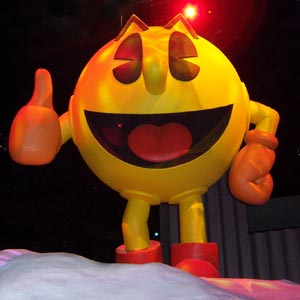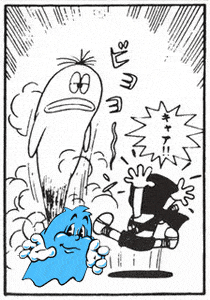The Pac-Man, Pakkuman or Puckman character

Pac-Man by Namco, Japan – 1980
![]() The Pac-Man, Pakkuman or Puckman character
The Pac-Man, Pakkuman or Puckman character
![]() As videogame legend has it, Iwatani took his inspiration for the shape of the Pac-Man character from seeing a pizza with a slice missing. Pac-Man’s form was dictated by punitative hardware limitations, which Iwatani used to his advantage in a move that was either a great insight or a marvelously lucky fluke: Pac-Man does not represent a physical, real-world being, he represents his primary function (eating).
As videogame legend has it, Iwatani took his inspiration for the shape of the Pac-Man character from seeing a pizza with a slice missing. Pac-Man’s form was dictated by punitative hardware limitations, which Iwatani used to his advantage in a move that was either a great insight or a marvelously lucky fluke: Pac-Man does not represent a physical, real-world being, he represents his primary function (eating).
This leap to iconic representation spread to every aspect of the game’s interface, putting in place some representation conventions and commonly understood gameplay rules that would be reiterated in countless games right up to the present day (for instance the concept of the power-up). The other advantage, possibly less important in the context of the largely narrative-free Pac-Man game, was that the minimalist representation allowed the player to ‘fill in the gaps’, superimposing an imaginary persona on a visual entity as yet too crudely represented to convey such characteristics explicitly.
“I designed Pac-Man to be the simplest character possible, without any features such as eyes or limbs. Rather than defining the image of Pac-Man for the player, I wanted to leave that to each player’s imagination.”

Obake and “Inky” from Baby Pac-Man
![]() The Ghosts movement and character
The Ghosts movement and character
![]() The four ghosts – Blinky, Pinky, Inky and Clyde, as they were known outside Japan – were based on Obake no Q-Taro, a famous cartoon ghost (TV series 1965-1967). Q-taro, a monster, is living with the Ohara family. He can fly and make his body transparent, but he cannot turn his body into other things like other monsters do. He is a scattered mind, and he always makes mistakes and causes trouble.
The four ghosts – Blinky, Pinky, Inky and Clyde, as they were known outside Japan – were based on Obake no Q-Taro, a famous cartoon ghost (TV series 1965-1967). Q-taro, a monster, is living with the Ohara family. He can fly and make his body transparent, but he cannot turn his body into other things like other monsters do. He is a scattered mind, and he always makes mistakes and causes trouble.
Pac-Man creator Toru Iwatani answers in an interview:
Interviewer: What was the most difficult part of designing the game?
Iwatani: “The algorithm for the four ghosts who are dire enemies of the Pac Man – getting all the movements lined up correctly. It was tricky because the monster movements are quite complex. This is the heart of the game. I wanted each ghostly enemy to have a specific character and its own particular movements, so they weren’t all just chasing after Pac Man in single file, which would have been tiresome and flat. One of them, the red one called Blinky, did chase directly after Pac Man. The second ghost is positioned at a point a few dots in front of Pac Man’s mouth. That is his position. If Pac Man is in the centre then Monster A and Monster B are equidistant from him, but each moves independently almost “sandwiching” him”
“The other ghosts move more at random. That way they get closer to Pac Man in a natural way. When a human being is constantly under attack like this, he becomes discouraged. So we developed the wave-patterned attack-attack then disperse; as time goes by the ghosts regroup and attack again. Gradually the peaks and valleys in the curve of the wave become less pronounced so that the ghosts attack more frequently.” said Iwatani San.
- Blinky – Chases. Will usually take the shortest route to you, and tends to follow.
- Pinky – Ambushes. Tends to take a more roundabout way to pac-man. Deadly.
- Inky – Freak. This dude acts strangely. He moves about the board fairly randomly,
but sometimes chases when he gets in close. - Clyde – Idiot. Moves randomly. Not much of a threat.
Cruise Elroy
Despite the moniker “Speedy”, Pinky is not the fastest ghost. All ghosts on all levels move at identical speeds, with one exception. The red ghost (“Shadow”, “Blinky”) will speed up once a certain number of pellets remain. This phenomenon is known as “Cruise Elroy” mode. Below is a table indicating when Blinky will enter Cruise Elroy mode:
Level Pellets remaining
1 20
2 30
3-5 40
6-8 50
9+ 60
Scatter Mode
The ghosts have an interesting pattern programmed into their movements: occasionally, they will simultaneously cease and desist their pursuit of Pac-Man and return to their respective corners of the maze, entering “scatter mode”.
“I felt it would be too stressful for a human being like Pac Man to be continually surrounded and hunted down. So I created the monsters’ invasions to come in waves. They’d attack and then they’d retreat. As time went by they would regroup, attack, and disperse again. It seemed more natural than having constant attack.”
Toru Iwatani, creator of Pac-Man
The ghost will enter scatter mode four times for each life on each level. As they exit the ghost house, you can easily see they begin play in scatter mode. Blinky heads for the top right corner, Pinky for the top left, Inky for the bottom right, and Clyde for the bottom left. When the ghosts enter scatter mode is determined by a timer. Generally the first two scatters are the longest in duration, and the third and fourth are about 2/3 as long. Beware Blinky: he can still pursue Pac-Man in scatter mode.
Individual personalities
Both Blinky and Pinky appear to be programmed to pursue Pac-Man directly. Pinky usually makes the opposite turn choice from Blinky when given a chance, and so this duo often can trap your man in a corner. Inky is a wildcard, and given the same situation often makes different choices. Inky definitely appears to be programmed to ambush Pac-Man. One theory is he heads for the end of the tunnel Pac-Man is currently moving down. Clyde moves randomly, and so can be the most frustrating ghost to work with.
Pac-Man’s ghosts have names and nicknames which were : Shadow (Blinky), Speedy (Pinky), Bashful (Inky), and Pokey (Clyde). The are red, pink, blue, and orange in color, respectively. In the original “Puckman”, the ghosts were named Oikake (Akabei), Machibuse (Pinky), Kimagure (Aosuke), and Otoboke (Guzuta). Puckman also had a DIP switch for alternate ghost names : Urchin (Macky), Romp (Micky), Stylist (Mucky), and Crybaby (Mocky).
![]() The first Pac-Man Topscorer
The first Pac-Man Topscorer
The arcade version of Pac-Man had a highest possible score of 3,333,360 which was achieved for the first time by Billy Mitchell on July 4th, 1999 in Weirs Beach, New Hampshire. Billy Mitchell is a native of Ft. Lauderdale, Florida. The highest high score can only be achieved by eating EVERY fruit and EVERY blue ghost on every one of the 256 levels in addition to every dot and energizer. Without losing a life. He arrived July 1st, with the sole purpose to beat the Canadians to the highest high score. He refused to eat until he had won. “I had to be the first,” Mitchell explains. “It’s like Neil Armstrong walking on the moon. No matter how many people who accomplish it afterwards, it will always be Armstrong who will be remembered for doing it first.” A few months before, Rick Fothergill of Hamilton, Ontario fell just 90 points short of the highest possible score. Mitchell also holds the world record on the classic Donkey Kong game (as of July 4th, 1999).
Billy Mitchell, Rick Fothergill, Chris Ayra, Tim Balderramos and Donald Hayes all hold the official record for this game on ‘Regular (TGTS)’ settings with a perfect score of 3,333,360 points on July 3, 1999, July 31, 1999, February 16, 2000, December 4, 2004 and July 21, 2005, also, respectively.
Chris Ayra holds the official record for the fastest time to get a perfect game on ‘Regular’ settings with 3:42:05 on April 2, 2002.
Ron Corcoran holds the official record for this game on ‘Speedup’ settings with 1,321,020 points on May 13, 2001.
